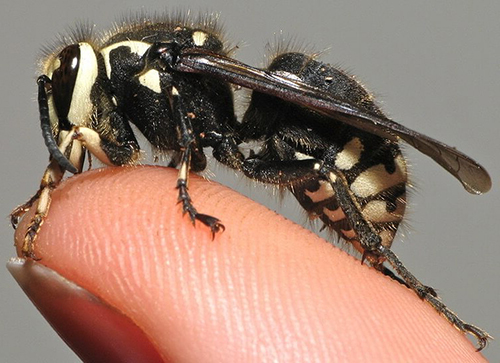
HORNETS
Scientific Name: Genus: Vespa
Fun Fact: European hornets were accidentally introduced to North America about the middle of the 19th century. However, they have never been found in western North America
Lifespan: 30-90 days
Description
Hornets are the largest of the wasps and look similar to yellowjackets. Some species can reach up to 2 inches in length. They are distinguished from other wasps in 2 ways: by the relatively large top margin of the head and by the rounded segment of the abdomen just behind the waist. Worldwide, there are 22 recognized species of Vespa. Most species only occur in the tropics of Asia, though the European hornet (Vespa crabro), is widely distributed throughout Europe, Russia, North America and Northeast Asia.
Like other social wasps, hornets build communal nests by chewing wood to make a papery pulp. Each nest has one queen, who lays eggs and is attended by workers who, while genetically female, cannot lay fertile eggs. Most species make exposed nests in trees and shrubs, but some (like Vespa orientalis) build their nests underground or in other cavities. In the tropics, these nests may last year-round, but in temperate areas, the nest dies over the winter, with lone queens hibernating in leaf litter or other insulative material until the spring.
Hornets are often considered pests as, except for the European hornet, they aggressively guard their nesting sites when threatened. The European hornet, however, rarely attacks people even those close to its nest. Other species, however, should be treated with great respect as their stings can be more dangerous and powerful than those of standard bees.
Life Cycle
In hornets native to North America, the nest begins in spring by the queen. She generally finds somewhere with adequate cover such as places like dark, hollow tree trunks or inside human built structures. The queen builds up to 50 cells out of chewed tree bark. The cells are arranged in horizontal layers known as combs. Each cell is vertical and closed at the top. An egg is then laid in each cell by the queen.
After about a week, the egg hatches, and in the next14 days the larva undergoes its five stages. During this time, the queen feeds the larva a diet rich in insect protein. The larva then spins a silk cover over the cell’s opening and, during the next two weeks the larva metamorpshises into an adult. The adult then eats its way through the silk cap. This first generation of workers are females and gradually undertakes all the tasks formerly carried out by the queen (foraging, nest building, taking care of the brood, etc.) with the exception of egg-laying, which remains exclusive to the queen.
Stings
Hornets have stings that they use to kill prey and defend hives. Hornet stings are more painful to humans than typical wasp stings because hornet venom contains a large amount of acetylcholine. Individual hornets can sting repeatedly. Unlike honey bees, hornets do not die after stinging because their stingers are very finely barbed and can easily be withdrawn and so they aren’t pulled out of their bodies when disengaging from an attack.
How to Get Rid of Hornets
Hornets are more aggressive than bees or yellow jackets. It is not advisable to attempt to remove hornet nests yourself. The safest method is to call a professional insect removal company, (aka an exterminator), to do this job for you. The risk of serious injury or death is just too great for amateurs with little to no experience. In the metro Columbus, Georgia area call Jarrod’s Pest Control (706-221-8000)
(706) 221-8000
REQUEST A QUOTE

100% Satisfaction
There is a reason our work is guaranteed…we do it right. If you would ever have a problem with pests while we are in charge of your pest control, we will work until the problem is resolved. Our contracts provide you with quarterly service and we will take care of any problems that may happen to arise between visits.
We Guarantee It!

Request Free Pest Inspection
EMERGENCY SERVICE AVAIALBLE
Request Free Pest Inspection
EMERGENCY SERVICE AVAIALBLE


